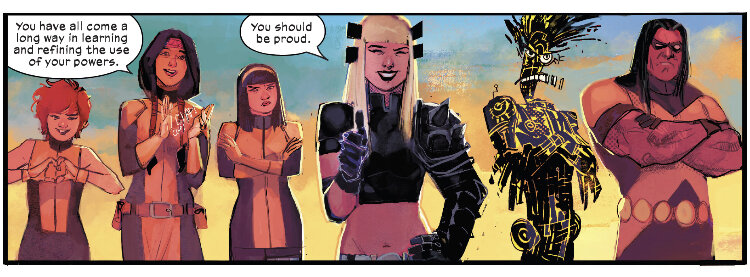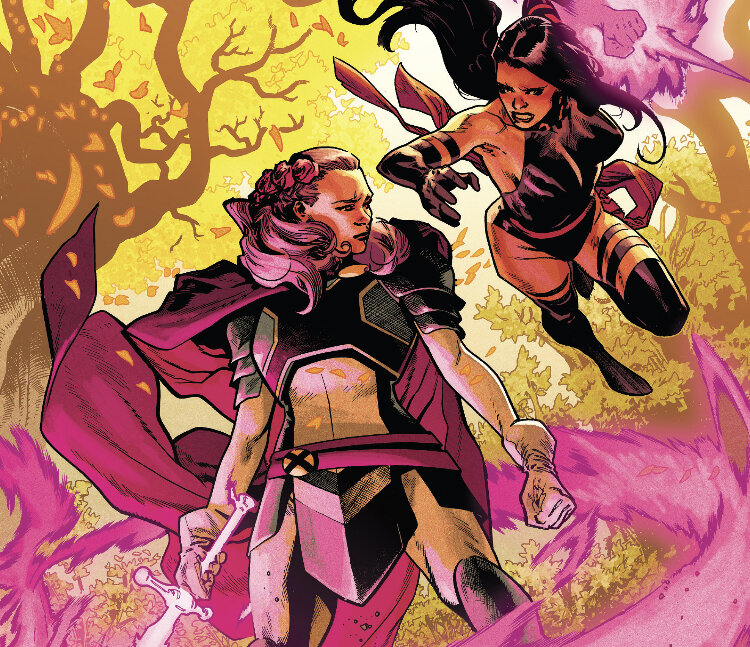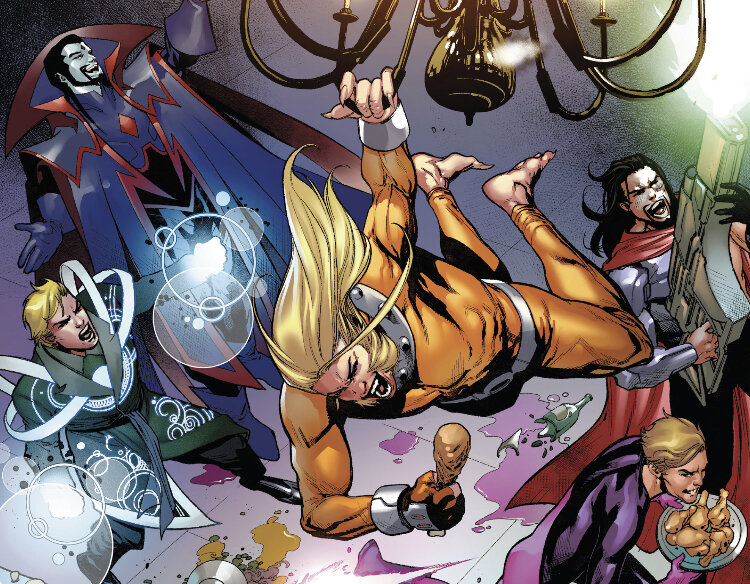Fireworks
“Fireworks”
Planet Size X-Men #1
Written by Gerry Duggan
Art by Pepe Larraz
Color art by Marte Gracia
• Is there life on Mars? Well, now there is. It was clear enough to anyone paying attention that this issue would be about the X-Men terraforming Mars, so going into the issue it was more about discovering exactly how and why this was being done. There were some things we already knew coming in – a need to replace their pharmaceutical facilities in the Savage Land to meet production goals, the pressure of learning that Nimrod was online and they couldn’t wait much longer on this part of the long-term plan of expansion – but in this story we learn that above all else, claiming Mars was about giving the Arakkii a proper home and getting around the problem of Earth suddenly being the host of millions of powerful, warlike mutants with no respect for humanity.
• The miracle of a circuit of omega mutants transforming a dead world into a planet that can permanently support life is remarkable and quite a thing to behold on the page – oh man, look at those X-Men go! It’s the freakiest show – but the real flex on display in this issue comes at the end in a text page in which Mars is renamed Arakko, humans are forbidden to go anywhere besides one particular zone devoted to diplomacy, and the planet is declared the capital of the solar system. Oh, right, and Arakko is the “first” mutant world, implying an empire to come. Well, I sure hope someone – like, say, the lead writer of the franchise who developed most of these ideas and only has four scheduled comic issues for the rest of the year – writes more about all of this!
• Pepe Larraz continues to dazzle with the sheer scope of his artwork and his gift for designing evocative new characters and settings. I don’t think there’s a lot of other artists who could’ve pulled this issue off with as much cinematic grandeur, but I say “cinematic” as though anyone working in cinema has approached some of the feats depicted so gracefully on these pages. The issue is full of things he’s designing from scratch that will become the basis of who knows how many other artists’ work – the Lake Hellas Diplomatic Ring, Port Prometheus, and the key Arrako leaders Xilo, Sobunar, and Lactuca – but the most incredible spectacle is how he manages to depict the transportation of millions of Arakkii mutants to their new planet. Every one of these pages is worth staring at and dissecting, the guy is just outstanding. The work he accomplished here cements him as one of the top tier definitive/transformative X-Men artists along with John Byrne, Arthur Adams, Jim Lee, Joe Madureira, and Frank Quitely.
• It feels a little strange that this issue wasn’t written by Jonathan Hickman but Gerry Duggan delivers here in a big way, conveying the grandeur of this moment while keeping it grounded in the characters, most especially Magneto and Jean Grey. Duggan pulls off a balancing act of writing in his own voice while matching Hickman’s tone, certainly much more so than any other writer in the stable. Some of this comes down to both of them understanding what they have in Larraz, an artist who thrives most when asked to do very narratively ambitious things. Duggan and Larraz have previously worked together on Uncanny Avengers and the two have real chemisty, so this issue sets the bar high for what they’ll be doing together soon on X-Men.
• Magneto is the star of this issue and the prime mover on the project to transform Mars into Arakko, and in this act he cements himself as a savior to his people on par with Xavier leading the creation of the Resurrection Protocols. And of course, there’s Apocalypse, who rescued the Arakkii from Amenth in the first place. The Great Men of mutantdom have in fact done miraculous deeds for their kind – why wouldn’t people follow them? Also, I don’t know if this is something Hickman and Duggan had in mind, but Magneto essentially giving “Lebensraum” to his liberated brethren is quite a thing for a Holocaust survivor.
• Absalon Mercator is the only omega mutant of Earth who does not participate in this very literal act of world-building, though we do see Magneto turned away from his mysterious realm in Otherworld. Clearly something is planned for Mercator, so the question is…when?
• I am not a scientist by any stretch, but the science in this issue seems fairly legit! The final text page gets into more details from the perspective of NASA and is attributed to Thom DiRocco, who turns out to be a real scientist that Duggan follows on Twitter, so it’s a reasonable to assume he was consulted on how to do this story as correctly as possible.
• It’s hard to fathom what it would be like to respond to the events of this issue as a human being. The notion of Mars suddenly being an inhabitable world full of powerful mutants with a totally alien society is wild, but living in a reality in which mutants are capable of doing these godlike feats would be a lot to process even if you’re already used to the idea of mutants and superheroes. I understand why a lot of people would feel frightened, but I feel like a lot of people would be awed and probably process this in religious terms of miracles and acts on behalf of God.
• It would seem the great error in all of this is the declaration of Arakko as the capital of the solar system when Arakko is definitely NOT on the same page as Krakoa and we know from X of Swords that this is a society that up until a few weeks ago was on a path of brutal conquest. Now, sure, some of that was due to the influence of Annihilation, but c’mon. Magneto, with his goal focused on expansion, is taking a massive leap of faith here – or, really, he’s just blinded by hubris. Also, it’s more than a little condescending to force Planet Arakko into a diplomacy role to teach them a better way of existing. And Storm rather bluntly speaks to greatest benefit of having the Arakkii on Mars – it’s basically a whole planet of incredibly powerful randos who can be a cannon fodder defense one planet away from Earth.
• The Arakkii being pushed into a diplomatic role is also not the best move given that they know almost nothing about Earth, much less the Shi’ar or any of the other Marvel alien societies. Maybe their lack of history with anyone besides the Krakoan mutants makes them theoretically neutral?
• It’s worth noting that the Arakkii precognitive mutant Idyll’s prophecy from X-Men #14 was clearly referencing what would eventually happen on Mars, the red planet.












